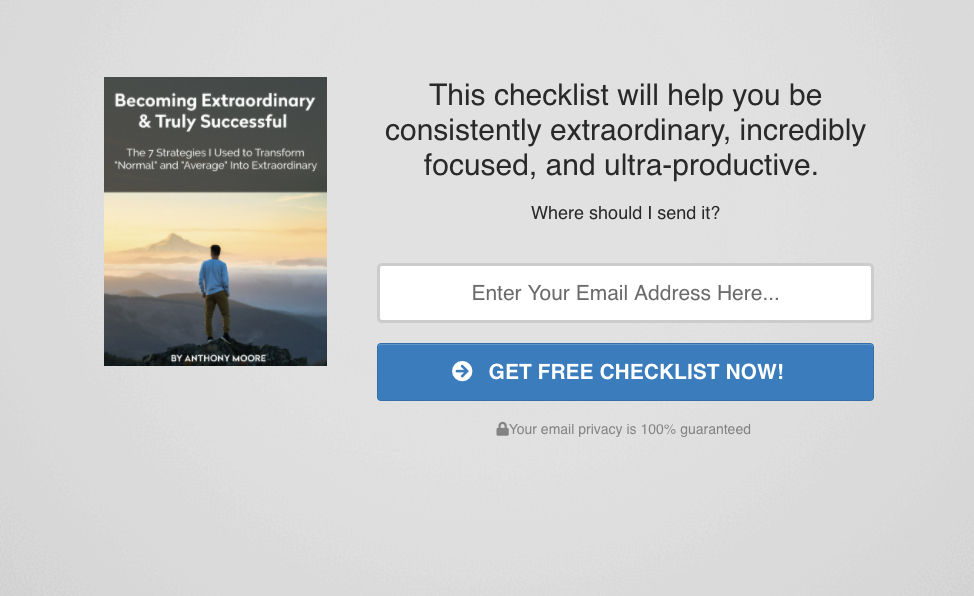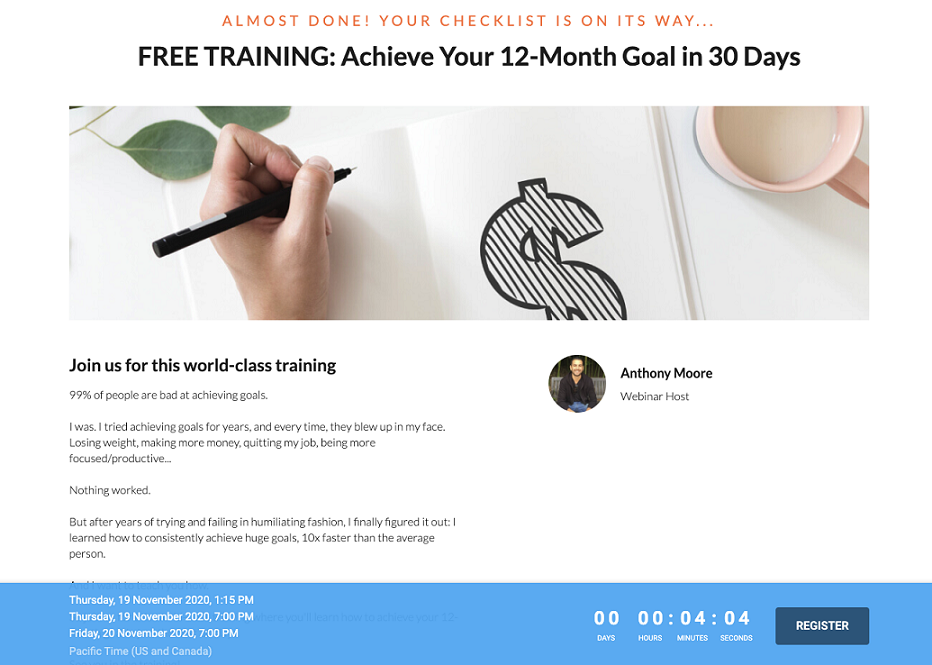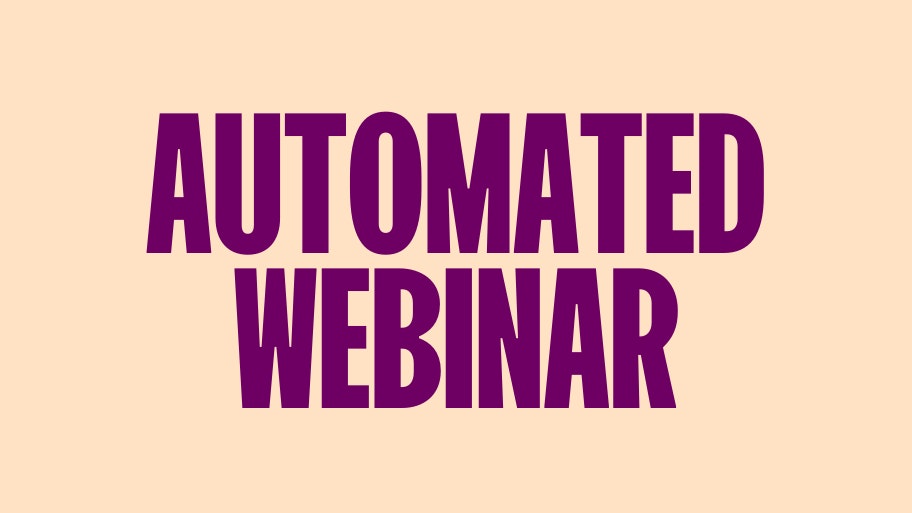In the past four years, I’ve built a six-figure writing business.
A huge part of my business comes through automated webinars.
As a self-employed entrepreneur, I went from making about $20,000 a year to over six figures this year. I’ve made my money through all kinds of income streams: book sales, coaching packages, freelance work, affiliate links, online courses, speaking engagements, consulting, etc.
But my most profitable income stream is, without a doubt, automated webinars.
After spending thousands of dollars and hundreds of hours researching, experimenting with, and using countless business tools, automated webinars have made me the most money – faster than almost any income stream.
The more you automate, the more money you make. According to MJ DeMarco (net worth $20 million) in his book The Millionaire Fastlane, a successful entrepreneurship enterprise must fit into the C.E.N.T.S system:
- Control
- Entry
- Need
- Time
- Scale
Automated webinars fit wonderfully into this system: They’re infinitely scalable, answer specific problems, require essentially zero time to maintain after setup, and give you absolute control over your sales processes.
I’ve made tens of thousands of dollars while I’ve slept using automated webinars, and it’s one of the best feelings in the world. Here’s a step-by-step guide to getting thousands of new customers using automated webinars for your business, whatever industry you’re in.



1. Create a 45- to 60-Minute Webinar
It takes a long time to build a winning webinar. But you can still get great results from a simple, short, hour-long webinar.
Webinars are a great way to sell high-priced products while getting customers on board with you, your brand, and your message. After experimenting with dozens of products, price points, and sales funnels, I’ve learned that you can usually sell most products under $150 using simple sales letters and sales pages. Beyond that, it gets very difficult to sell to customers without using something like a webinar.
→ Click Here to Launch Your Online Business with Shopify
There are countless schools of thought on how to best structure your webinar, but the overall structure is usually something like this:
- Introduction (~five minutes)
- Teaching your content (~30–40 minutes)
- Selling your product (~ten minutes)
After getting hundreds of feedback responses from webinar attendees over the years, I’ve learned this model is the best way to give a good webinar.
Essentially, the more you teach, the higher you can price your product. I’ve gone to three-day-long webinars, with about two hours of content each day; the final product for those could be anywhere from $1,000 to $10,000.
Whatever your product is, you need to create an excellent webinar that really helps people. Some average industry-standard conversion rates to keep in mind:
- 20–30 percent of registrants will actually show up to the live event
- 10 percent of no-show registrants will watch the replay
- 10–15 percent of webinar attendees will buy your product
Once you create your webinar (and it does well!), you have the materials you need to start automating the entire process.

2. Set Up Your Automated Webinar System
It’s essential to have tools that allow you to automate your webinar recording once it’s done. To be sure, these tools are an investment, but they’re one of the best investments you can make for your business.
Most webinar platforms have features that let you automate previous webinar recordings. I bought WebinarJam for about $500/year, and I had to upgrade to their EverWebinar platform (about $300/year) to start automation systems.
This might seem like a lot to you – my first year as an entrepreneur, I made around $20,000. These seemed like extremely expensive tools! But they’re one of the best investments I’ve ever made, and I’ve made tens of thousands of dollars through these tools alone.
Once you have the recording of your webinar, it’s time to set up the automated webinar recording. For me, along with countless other world-class entrepreneurs I’ve studied, there’s no better place to position this automated webinar than right upon subscribing to your content.
I get around 50–150 new email subscribers every day. When people enter their email and sign up for my email list, they’re immediately taken to a thank-you page, along with a webinar registration page.
My email signup page:

It leads right to my webinar signup page:

I have about a 20 percent sign-up rate for my webinars (for every 100 new subscribers to my email list, 20 will also sign up for the webinar). That’s an incredible ratio! Every day, around 20 people are seeing my automated webinar, learning my content, seeing who I am, and sitting through my sales pitch.
You can program these webinars to run all the time: For me, I set my webinar to run every 15 minutes, as well as at 7:00pm each night. This allows new subscribers to immediately watch the webinar, or wait to watch it after they have dinner.
You can’t do this manually. I have readers all over the world, in every possible timezone. Remember: The more you automate, the more money you make. If you want to maximize your profits and reach, you have to create some backend systems that account for all scenarios.
3. Create Back-End Systems That Follow-Up With All Registrants
I’ve since hired some professional business coaches to take care of everything for me (thank God), because there’s a lot to say here, and it can make your head spin. But I’ll keep things simple.
There are three tags you want to place viewers in:
- Registered for webinar
- Attended webinar (buyers/non-buyers)
- Registered, but did not attend webinar
Your messaging should be different for each group, and your sales depend on how well you engage each type.
Registrants
For registrants, there are specific messaging sequences you should send to maximize attendance. (I’d recommend Russel Brunson’s Perfect Webinar script, which has given me great results.)
Basically, you want to get as many registrants as possible to actually show up. For me, I use stories, testimonials, and teasing free gifts for all attendees, really hyping up how awesome the webinar will be.
Don’t be afraid to send several emails about this; people signed up for the webinar, and they’re more open to getting reminders about it.
Attended Webinar
For those who attended the webinar, there are two groups: those who bought your product, and those who didn’t.
For those who bought it, great! For those who didn’t, I’d recommend having a simple automated email survey asking them why they didn’t buy/their biggest concerns, and keep them in mind for future sales.
The best webinars are tested and tweaked over time until you strike gold and really build a winner – something else I had to learn over years of trying.
Registered, but Did Not Attend Webinar
These no-shows will comprise the bulk of your registrants, which is just how webinars work nowadays.
But these people have shown interest in you, and you must re-engage them through new webinars, new videos, and new ways to get them excited.
The best way to get no-shows reengaged is to send them new forms of content (videos, articles, podcasts, etc.) that remind them that you’re a trusted authority who has interesting content and useful solutions to their problems.
4. Direct All Traffic To the Automated Webinar
Webinars are a numbers game; the more people that show up, the higher your conversion rates will be.
I direct all new traffic to the automated webinar. Everyone sees it. Not only is it a great selling tool, but it’s an excellent way to build trust and rapport with new subscribers, it gives them a face to match my name, and they get free high-level training just for signing up.
I’d recommend getting as many new readers/viewers in the training as possible. Some other great places to promote your webinar:
- A few days after they subscribe (after sending them more information about you/your story)
- A weekly/monthly email blast inviting all current subscribers to join the webinar on certain days/times
- During big events (holidays, sales events, beginning of the year, etc.)
- Right after they purchase a smaller product
Remember, it’s a numbers game. Automated webinars are an excellent money-maker, and it’s worth it to prioritize this model and try and get as many people as possible signed up.
In Conclusion
There’s so much more I can say here, but I’ll end with this: Automated webinars are one of the best possible tools you can use to scale your business, connect with your subscribers on a deep level, and make enormous income while you sleep.
It takes a lot of work; there are lots of tools and strategies you need to learn to make this all work.
But if you want to become a six-figure entrepreneur and build an insanely profitable business, you need to heavily invest in yourself and your business.
There aren’t many better investments than learning how to automate webinars.






